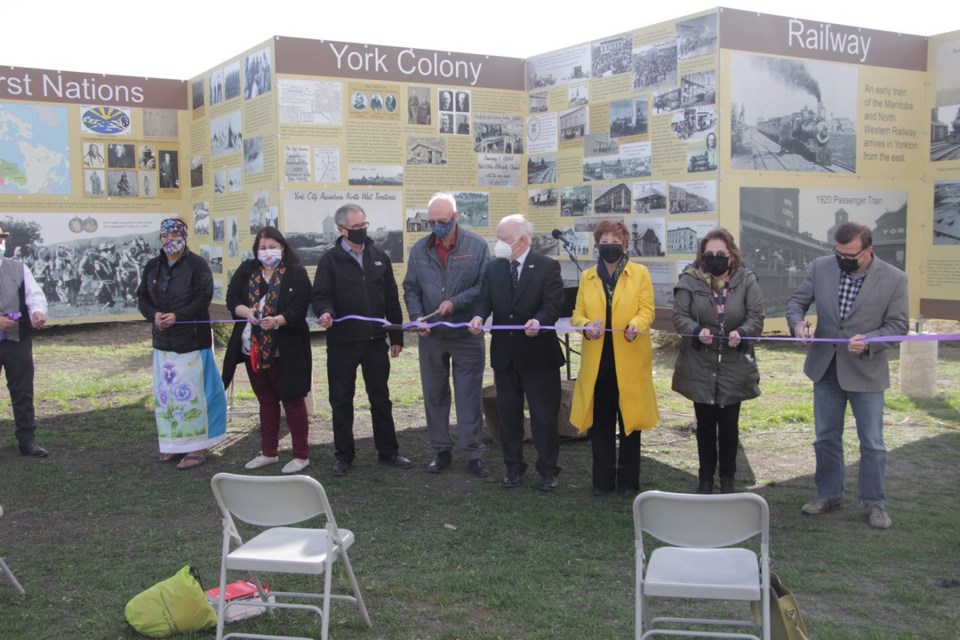The Yorkton Brick Mill Heritage Society has reached a major milestone. The signs detailing the history of the mill are up, and people can now learn more about the history of the region, starting with the First Nations and continuing to today.
Larry Pearen with the Yorkton Brick Mill Heritage Society said it’s exciting to have something tangible they can show the public. Over $330,000 has been raised so far for repairs, and they are almost at the point where people can again enter the building safely, and the signs are another part of the larger plans for the site.
“We’re so glad this is finally up, we have a chance to see it, then we can move forward. People know we are serious about this. Interior repairs, nobody can see the repairs to the foundation.”
One of the challenges of the design was to make something that could withstand the wind, something that was tested during the ribbon cutting as it was a very windy day. The structure, built out of aluminum, is in a zig-zag pattern, which Pearen explained was decided to make it withstand the weather.
“This is very strong, we’re excited about that! Saskatchewan has been getting more wind these past few months, and it has withstood it.”
The Yorkton Tribal Council was a major contributor to the project, and they were given the lead on the panels discussing First Nations history. Tribal Chief Isabel O’Soup said it has been overwhelming to see the final result.
“It just warms my heart that my ancestors are finally going to be recognized, you know? That’s really the bottom line… I say that because the history of Canada and First Nations people has not been [recognized], there’s a black mark on history there. We work really hard to get past that. And I mean, other people are working hard to get past that as well, so it’s overwhelming. It’s an honor to see our history up there.”
O’Soup does have one thing she wants to see on the mill site that she isn’t seeing now, and that’s more young people involved in the project. She said that she has seen seniors working hard on the mill project, but she hasn’t seen very many young people working on the project, and she said that we need to find ways to get young people more involved in projects that involve history.
“In our First Nations community, it would be blasphemy to see all these old people working and young people sitting at home! Having said that, it’s the importance of history, we probably don’t see that until we get older. I just think that we should have more. If somebody’s coming, bring your grandson, bring your granddaughter, that’s the only way we’re going to learn it.”
She also notes that it’s often the case that people don’t know how First Nations history and the Brick Mill intersect. Since the initial push was towards making people farmers on reservation, she said that the Brick Mill was an important link in the chain for the reservations that surround Yorkton, something many people don’t realize.
“Everybody has a connection to it, whether we know it or not,” said O’Soup.
The project has had the support of the City of Yorkton, but Mayor Bob Maloney noted that this wasn’t always the case, and previous councils were not always on side, but that the dedication of the Brick Mill committee and the work that they’ve done has been what has turned people around. When the project began, there were considerable obstacles to overcome, including structural stability and major damage. However, saving the building is vital because Yorkton has lost a great deal of its heritage already.
“We haven’t done a good job of protecting history in the city. In fact, we haven’t been proactive at all and I think this is one of the few projects that council has gotten behind. The reason behind it is because of the committee that came together to save the mill. They’ve done a lot of terrific work. I mean, this is the only brick mill left in Saskatchewan, I mean it’s the oldest historical building we have left. It’s the historical building that we have left in the city, and I am so pleased that so many people have come together to save it. I think it behooves council to stay on the right side of this project, I see nothing but good things for this site and what’s being developed here.”
Maloney is also impressed by the wealth of information on the boards at the site.
“If people haven’t seen the story boards yet I encourage them to come and look. I consider myself to be a bit of a Yorkton historian, and there are pictures on this board that I have never seen.”
Maloney also said that the Yorkton Tribal Council’s involvement has been something that was important to get a more complete view of the history of the region.
“If you’re going to tell their story, they should be telling the story.”
The society is now looking for sponsors for panels. For an eight by eight panel the cost is $2,000.
“The more we pay this off, the more we can move forward with other developments,” said Pearen.
The next step for the Mill is the addition of an interpretive centre. The plan is to make a two-storey structure inspired by the railway station, in the same rough footprint as a building that was torn down. It will tell the story of grains and milling in Saskatchewan.




